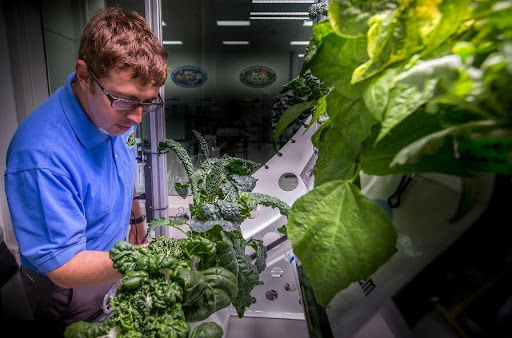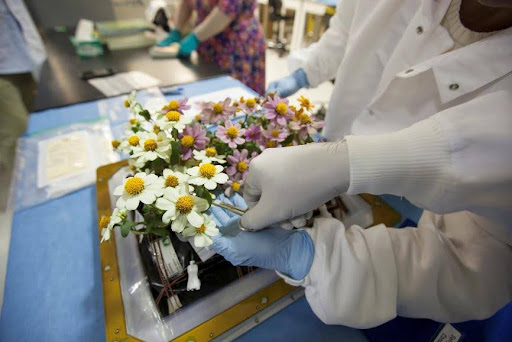Introduction:
Above Earth’s Curve, where gravity loosens its grip, something is blooming. Nestled among wires, blinking instruments, and the hum of life–support systems, delicate leaves unfurl towards LED lights, their roots suspended in air and mist. This isn’t science fiction – it’s humanity’s first attempt in cultivating life beyond the cradle of our planet.
At Space India, During, the “Space Explorers Workshop”, “Space Café” students get an opportunity to work as space scientists and understand the importance of a balanced diet for astronauts’ health in space. They learn about the unique environment, including the use of specially engineered food packages and processes like freeze-drying and irradiation giving space biology education. The workshop emphasizes the importance of nutritional value, portion size, and minimal wastage in selecting food items for space missions.

On the International Space Station, astronauts do receive regular shipments of various freeze-dried and prepackaged meals to cover their dietary needs from Earth. However, the vitamins in prepackaged form break down over time and as humanity prepares for long-duration manned space missions, crew nutrition during their extended time in space is a crucial aspect to address.
A Solution?
– Space gardens residing on the space stations – for example, the Vegetable Production System, known as VEGGIE, as part of NASA space programs.
What do Plants Require to Grow?
Sunlight, proper temperature, moisture, air, and nutrition are the five factors on which plant growth is dependent. Each factor enables specific life processes in a plant cell. Sunlight enables photosynthesis for energy production, Temperature enables Enzyme Activity, Water is nutrient transport, Air responsible for cellular respiration and lastly nutrition enables Biosynthesis and Growth.

Influence of “Microgravity” on plant growth:
When one is aboard an orbiting observatory, the influence of the Earth’s gravitational pull is notably reduced – a state referred to as “microgravity”.
It significantly affects
- Plant Physiology
- Gene Expression in Plants
On board the space shuttle flight STS-95, experiments were conducted to compare ground-grown and space-grown Arabidopsis and Rice. On Earth, aerial parts of the plant (shoots) grow upward while roots grow downward, known as geotropism. However, the experiments showed that in a microgravity environment, the growth direction is unregulated, and some roots even extend in the same direction as the aerial stems. This phenomenon can be attributed to the asymmetric distribution of plant growth hormone ‘Auxin’ in the absence of gravity.
What is VEGGIE?
It stands for a low-cost “Vegetable Production System” launched into orbit on April 18, 2014.
Resembling a piece of carry-on luggage the program was designed to accommodate six plants. It runs on about 70 watts for the lights, fans and control electronics. Each plant grows in an individualized “pillow” with fertilizer media, and water is supplied via passive wicking (plants draw up water via a fibrous material like nylon). A bank of light-emitting diodes (LEDs) above the plants produces a spectrum of light – rich in red and blue wavelengths – enabling for the plant’s photosynthesis and growth in a particular orientation (phototropism). The system also harbours a fan apparatus, allowing air circulation and ensuring humidity bubbles aren’t formed. A potential concern is the growth of harmful microbes on the produce; however, no contamination has been reported to date.

Results till now…
Thus far, astronauts have successfully grown eight different types of leafy greens like Chinese Cabbage, Mizuna Mustard, Red Russian Kale and Zinnia flowers. As part of each plant experiment in VEGGIE, researchers at Kennedy Space Centre and College grow crops on the ground in sync with the orbital experiments as a control group.

Astronauts like Peggy Whitson (NASA) aboard the ISS really love this simple, low-power system that grows fresh and nutritious pick-and-eat salad crops, as well as enhancing psychological well-being (Gardening is fun!). As seeds are being sown in the orbit, we have planted the promise of sustainability, and life wherever our journey through the cosmos may take us. Finally, the future of farming isn’t just grounded – it’s reaching for the stars.
—
If you like the blog, enrol your school or yourself (k-12 student) in our School Programs or Online Programs, call us at +91-74020 74020 or write to us for any query: getintouch@space-india.com

